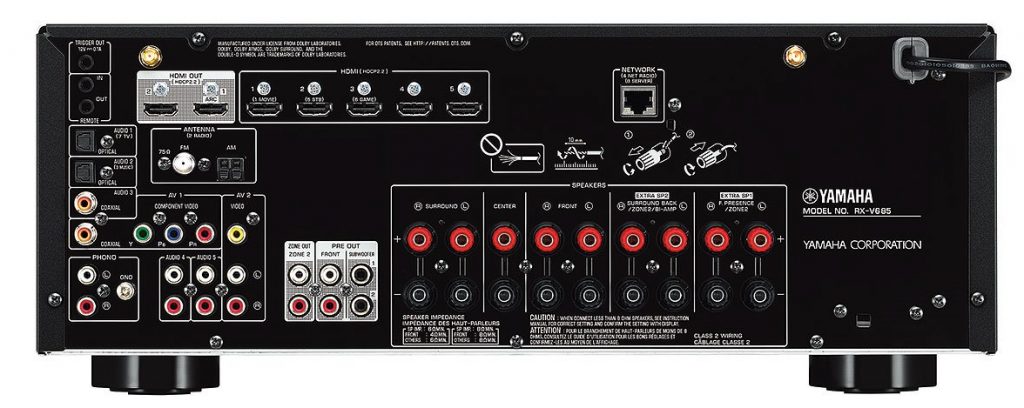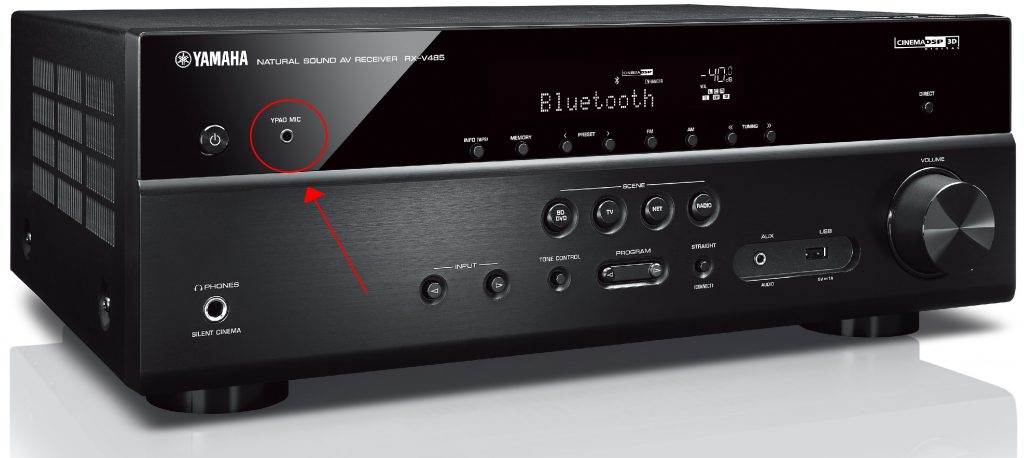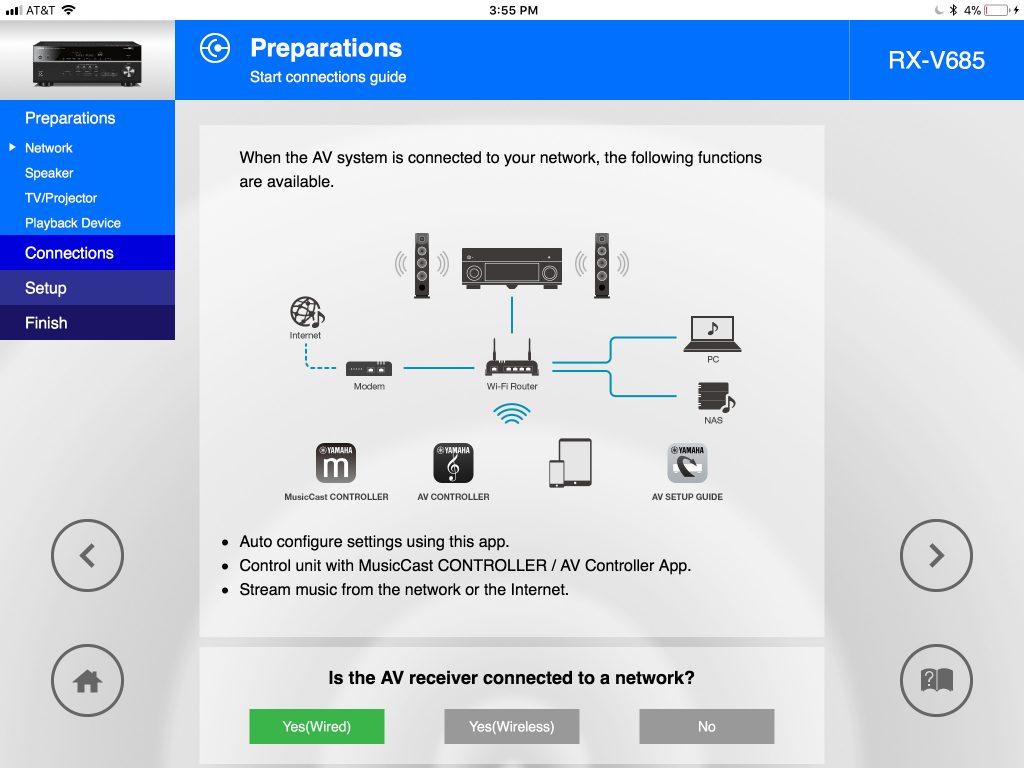Should I Keep My Audio Receiver Plugged In
In Part 1 of this two-part article, we talked about Hullo-Fi receivers . Now allow's shift the focus to AV receivers, which alive up to the acronym in their name by supporting multiple audio formats (including surround audio) as well as video formats. Most AV receivers handle everything a Hi-Fi receiver can — plus a whole lot more.
If yous have a domicile theater system, an AV receiver is a must for distributing video to your Television, video monitor or projector, and the audio to your multichannel speaker organisation.
What Goes In
The back of an AV receiver typically offers a collection of connectors that make the back of a Hullo-Fi receiver look simple. For ane affair, it will probable include multiple HDMI® inputs for connecting video devices such as cable or satellite Tv boxes, game consoles, Blu-ray/DVD players and/or streaming devices such equally Roku™ or Apple Television®. For example, the Yamaha RX-V685 receiver has v HDMI inputs and two HDMI outputs:

When several video sources are plugged in, you can use the receiver, or its remote control, to select which input y'all meet on your screen.
Other inputs you're likely to find on an AV receiver include those for analog video formats such as component video and composite video, along with their accompanying audio ports, all of which are usually on RCA connectors. Although near all video today is digital, these legacy ports are useful for supporting older devices (such as VHS players) that were manufactured when analog video was the standard.
On the audio side, AV receivers typically offer line-level audio inputs for devices similar CD players, and many (including the RX-V685) fifty-fifty take phono inputs — which we discussed in Part 1 — for connecting a turntable such as the Yamaha TT-S303 . You lot'll also commonly notice coaxial inputs of the digital diverseness, which offer another pick for audio input from external devices.
Not all the connections are on the back, nonetheless. In addition to a headphone jack, the front panel of nearly AV receivers will provide an input for connecting devices such as smartphones, tablets and laptops as well as a USB input for plugging in a storage device with music files on it, such every bit a flash drive. The reason these jacks are on the front is that they're more likely to exist used for temporary connections to devices rather than permanent ones, so accessibility is of greater importance.
YPAO (Yamaha Parametric room Acoustic Optimizer)-equipped Yamaha AV receivers such as the RX-485 also provide a front end console jack for their included microphone. This feature allows you lot to automatically tune your system based on the acoustics of your room.

On the Network
It'south important for an AV receiver to be able to connect to the net via your habitation network — a necessity for streaming online content. A network connection also lets you access music libraries and other content y'all have on your mobile devices or home computers.
Yamaha AV receivers like the RX-V485, RX-V685 and many others requite yous both wired and wireless network options: You can either connect direct from your router via an Ethernet cable plugged into the Network jack on the back of the receiver, or yous tin can connect via Wi-Fi.
Some other wireless format that some gimmicky AV receivers support (including many Yamaha models) is Bluetooth ® . This kind of connection allows you to stream music wirelessly from smartphones, tablets, laptops and other devices into your receiver and and then route it to your speakers. The RX-V485 and RX-V685 offering not merely this kind of input but Bluetooth output every bit well, for sending music to your headphones and earbuds.
At that place'southward actually another type of wireless reception that nearly AV receivers support, though it may appear a little less obvious: AM and FM radio. Similar Hi-Fi models, AV receivers will as well typically include external antennas to meliorate radio reception.
On the Outs
Now allow's look at what makes these receivers really special: their ability to transport incoming video to your TV or projector in upwardly to 4K resolution, as well every bit decode and amplify incoming sound and road it to the correct speakers in your surroundings sound setup.
Present, there are many dissimilar surround formats. Non all AV receivers can handle all of them. For example, the RX-V485 supports up to 5.1 surround sound (forepart left, right and heart speakers, rear left and right and a subwoofer — the ".1" in the equation), while the RX-V685 gives you up to 7.ii surround, which adds two additional rear speakers and another subwoofer to the 5.1 configuration. It also supports two kinds of "immersive" environment sound: DTS:10™ and Dolby Atmos ® (which adds elevated speakers and then that some sounds come up from to a higher place you lot).

Many Yamaha AV receivers are also equipped with a feature called Movie theatre DSP, which is a digital processing arrangement that simulates a selection of 3D sound spaces, optimized for a variety of categories in both video and music. For the old, you lot can choose from simulations for Adventure, Drama and Sci-Fi content, amid many others. For music, the options include a Vienna music hall, the Roxy Theater and the Bottom Line (a onetime New York music lodge). Even if yous but accept stereo speakers, you tin can simulate surround with the Virtual Cinema DSP feature offered past many Yamaha receivers.
Amped Up
As we discussed in Part 1 , Hi-Fi receivers are designed to provide amplification for the left and correct speakers of a stereo system. The distension sections of AV receivers take to be much more complex and powerful in order to bulldoze the six or more speakers in a surround arrangement.
With so many speakers and and then many connectors, yous might recall connecting the speaker cables for a surround system would be a difficult and confusing chore. Fortunately, most receivers have well-labeled output jacks on the rear console, and equally long as you connect the correct speaker to the proper jack, y'all shouldn't have whatever problems. Yamaha offers a free mobile app called AV Setup Guide to assistance you get your arrangement up and running:

Many Yamaha AV receivers, including the RX-V685, RX-V485, AVENTAGE 1080 and AVENTAGE 3080 , come with wireless remote controls that allow you lot to operate all their features from the condolement of your easy chair. They also all support the Yamaha MusicCast system, which lets you lot use wireless powered speakers for cablevision-free stereo or surround systems — even multi-room ones!
If you're looking to create a versatile system that tin can play video and audio in all the pop formats, a quality AV receiver is essential. By allowing the interconnection and integration of virtually any type of consumer video or audio gear, it enables you to create a powerful home theater system that will proceed yous entertained for many years to come.
Click hither for more information near Yamaha AV receivers.
Should I Keep My Audio Receiver Plugged In,
Source: https://hub.yamaha.com/audio/gear/whats-a-receiver-part-2-av/
Posted by: hamiltontheireses.blogspot.com


0 Response to "Should I Keep My Audio Receiver Plugged In"
Post a Comment